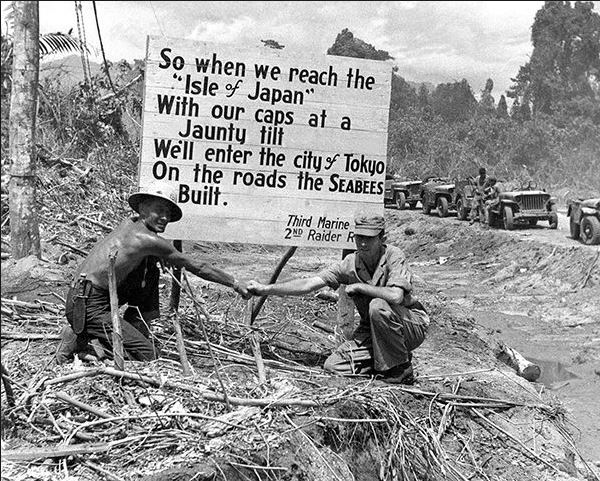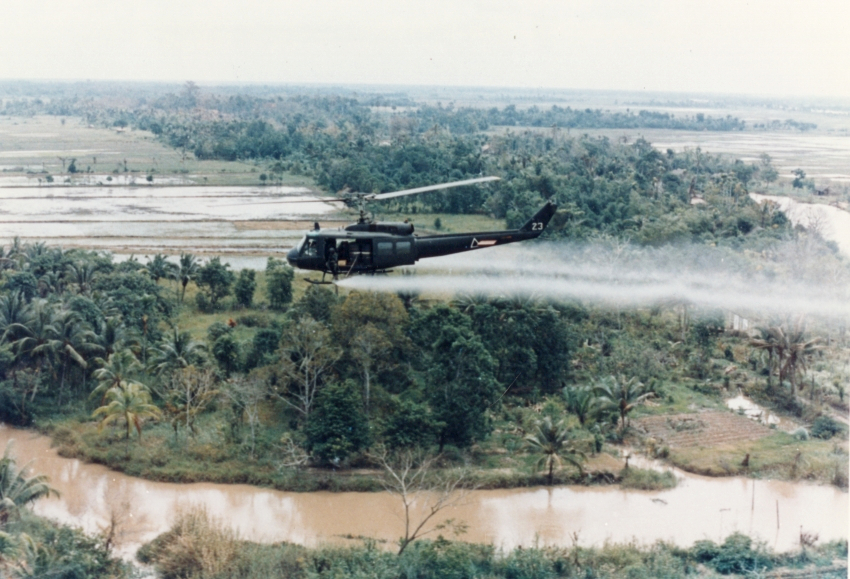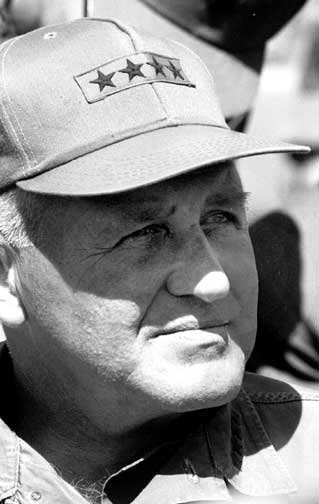|
Nam Can Naval Base
Nam Can Naval Base is a former Republic of Vietnam Navy (RVNN) and United States Navy in the town of Năm Căn, Cà Mau Province in the extreme south of Vietnam. History Located at the extreme southern tip of South Vietnam, Năm Căn was a swampy fishing and charcoal-collecting village which had been overrun by the Viet Cong (VC) during the Tet Offensive and almost totally destroyed. The few primitive old roads were abandoned and useless. Until 1969 the area had been left to the VC. U.S. leaders recognized that to sustain a military presence deep in the Cà Mau Peninsula they had to develop a permanent logistics capability in the region. The repair ships, self-propelled Barracks ships and Landing Ship, Tanks (LSTs) deployed to the Gulf of Siam in December 1968 were too distant from the inland operational areas so the Allies had to find another way to supply the riverine forces. Admiral Elmo Zumwalt ordered the construction of an Ammi barge pontoon base mid-point in the Cửa ... [...More Info...] [...Related Items...] OR: [Wikipedia] [Google] [Baidu] |
Republic Of Vietnam Navy
The Republic of Vietnam Navy (RVNN; ; ''HQVNCH'') was the naval branch of the South Vietnamese military, the official armed forces of the former Republic of Vietnam (or South Vietnam) from 1955 to 1975. The early fleet consisted of boats from France; after 1955, and the transfer of the armed forces to Vietnamese control, the fleet was supplied from the United States. With American assistance, in 1972 the VNN became the largest Southeast Asian navy and, by some estimates, the fourth largest navy in the world, just behind the Soviet Union, the United States and the People's Republic of China, with 42,000 personnel, 672 amphibious ships and craft, 20 mine warfare vessels, 450 patrol craft, 56 service craft, and 242 junks. Other sources state that VNN was the ninth largest navy in the world. The Republic of Vietnam Navy was responsible for the protection of the country's national waters, islands, and interests of its maritime economy, as well as for the co-ordination of maritime p ... [...More Info...] [...Related Items...] OR: [Wikipedia] [Google] [Baidu] |
Patrol Craft Fast
Patrol Craft Fast (PCF), also known as Swift Boats, were all-aluminum, long, shallow-draft vessels operated by the United States Navy, initially to patrol the coastal areas and later for work in the interior waterways as part of the brown-water navy to interdict Vietcong movement of arms and munitions, transport South Vietnamese forces and insert SEAL teams for counterinsurgency (COIN) operations during the Vietnam War. Development Conception The Swift Boat was conceived in a ''Naval Advisory Group'', Military Assistance Command, Vietnam (NAVADGRP MACV) staff study titled "Naval Craft Requirements in a Counter Insurgency Environment," published 1 February 1965. It noted that "counterinsurgency water operations are difficult, demanding, and unique. A prevalent belief has been that COIN craft can readily be obtained from existing commercial and naval sources when needed. Unfortunately, no concerted effort has been made to develop COIN craft specifically suited to perform th ... [...More Info...] [...Related Items...] OR: [Wikipedia] [Google] [Baidu] |
Naval Installations Of The Republic Of Vietnam
A navy, naval force, or maritime force is the branch of a nation's armed forces principally designated for naval warfare, naval and amphibious warfare; namely, lake-borne, riverine, littoral zone, littoral, or ocean-borne combat operations and related functions. It includes anything conducted by surface Naval ship, ships, amphibious warfare, amphibious ships, submarines, and seaborne naval aviation, aviation, as well as ancillary support, communications, training, and other fields. The strategic offensive role of a navy is Power projection, projection of force into areas beyond a country's shores (for example, to protect Sea lane, sea-lanes, deter or confront piracy, ferry troops, or attack other navies, ports, or shore installations). The strategic defensive purpose of a navy is to frustrate seaborne projection-of-force by enemies. The strategic task of the navy also may incorporate nuclear deterrence by use of submarine-launched ballistic missiles. Naval operations can be broa ... [...More Info...] [...Related Items...] OR: [Wikipedia] [Google] [Baidu] |
Landing Craft Support
The Landing Craft, Support (Large) were two distinct classes of amphibious warfare vessels were used by the United States Navy (USN) in the Pacific and the Royal Navy in World War II. The USN versions which were later reclassified Landing Ship Support, Large also performed radar picket duty and fire fighting. US Navy Vessels The original designation for the ships was LCS(L)(3), which stood for "Landing Craft Support (Large) Mark 3". In 1949 the class was reclassified to "Landing Ship Support, Large" (LSSL). The United States Navy had to have the designation LCS(L) because there was also a smaller class named LCL, that were built mainly for rescue and smoke laying during amphibious operation. Design and manufacture A total of 130 were made. Three different ship building yards did the construction: George Lawley & Son ( Neponset, Massachusetts); Commercial Iron Works (Portland, Oregon); and Albina Engine Works (Portland, Oregon). The hull was the same as the Landing Craft In ... [...More Info...] [...Related Items...] OR: [Wikipedia] [Google] [Baidu] |
Seabee
United States Naval Construction Battalions, better known as the Navy Seabees, form the U.S. Naval Construction Force (NCF). The Seabee nickname is a heterograph of the initial letters "CB" from the words "Construction Battalion". Depending upon context, "Seabee" can refer to all enlisted personnel in the USN's occupational field 7 (OF-7), all personnel in the Naval Construction Force (NCF), or Construction Battalion. Seabees serve both in and outside the NCF. During World War II they were plankowner, plank-holders of both the Naval Combat Demolition Units and the Underwater Demolition Teams (UDTs). The men in the NCF considered these units to be "Seabee". In addition, Seabees served as elements of Cubs, Lions, Acorns and the United States Marine Corps. They also provided the manpower for the top secret CWS Chemical Warfare Service: Flame Tank Group Seabees, Flame Tank Group. Today the Seabees have many special task assignments starting with Camp David and the Naval Support Unit at ... [...More Info...] [...Related Items...] OR: [Wikipedia] [Google] [Baidu] |
Seabees
United States Naval Construction Battalions, better known as the Navy Seabees, form the U.S. Naval Construction Force (NCF). The Seabee nickname is a heterograph of the initial letters "CB" from the words "Construction Battalion". Depending upon context, "Seabee" can refer to all enlisted personnel in the USN's occupational field 7 (OF-7), all personnel in the Naval Construction Force (NCF), or Construction Battalion. Seabees serve both in and outside the NCF. During World War II they were plankowner, plank-holders of both the Naval Combat Demolition Units and the Underwater Demolition Teams (UDTs). The men in the NCF considered these units to be "Seabee". In addition, Seabees served as elements of Cubs, Lions, Acorns and the United States Marine Corps. They also provided the manpower for the top secret CWS Chemical Warfare Service: Flame Tank Group Seabees, Flame Tank Group. Today the Seabees have many special task assignments starting with Camp David and the Naval Support Unit at ... [...More Info...] [...Related Items...] OR: [Wikipedia] [Google] [Baidu] |
Agent Orange
Agent Orange is a chemical herbicide and defoliant, one of the "tactical use" Rainbow Herbicides. It was used by the U.S. military as part of its herbicidal warfare program, Operation Ranch Hand, during the Vietnam War from 1961 to 1971. It is a mixture of equal parts of two herbicides, 2,4,5-T and 2,4-D. In addition to its damaging environmental effects, traces of dioxin (mainly TCDD, the most toxic of its type) found in the mixture have caused major health problems for many individuals who were exposed, and their offspring. Agent Orange was produced in the United States from the late 1940s and was used in industrial agriculture and was also sprayed along railroads and power lines to control undergrowth in forests. During the Vietnam War, the U.S. military procured over 20 million gallons consisting of a fifty-fifty mixture of 2,4-D and dioxin-contaminated 2,4,5-T. Nine chemical companies produced it: Dow Chemical Company, Monsanto Company, Diamond Shamrock Corporation, ... [...More Info...] [...Related Items...] OR: [Wikipedia] [Google] [Baidu] |
United States Air Force
The United States Air Force (USAF) is the air service branch of the United States Armed Forces, and is one of the eight uniformed services of the United States. Originally created on 1 August 1907, as a part of the United States Army Signal Corps, the USAF was established as a separate branch of the United States Armed Forces in 1947 with the enactment of the National Security Act of 1947. It is the second youngest branch of the United States Armed Forces and the fourth in order of precedence. The United States Air Force articulates its core missions as air supremacy, global integrated intelligence, surveillance and reconnaissance, rapid global mobility, global strike, and command and control. The United States Air Force is a military service branch organized within the Department of the Air Force, one of the three military departments of the Department of Defense. The Air Force through the Department of the Air Force is headed by the civilian Secretary of the Air Force ... [...More Info...] [...Related Items...] OR: [Wikipedia] [Google] [Baidu] |
Creighton Abrams
Creighton Williams Abrams Jr. (September 15, 1914 – September 4, 1974) was a United States Army general who commanded military operations in the Vietnam War from 1968 to 1972, which saw United States troop strength in South Vietnam reduced from a peak of 543,000 to 49,000. He was then Chief of Staff of the United States Army from 1972 until his death in 1974. In 1980, the United States Army named its then new main battle tank, the M1 Abrams, after him. The IG Farben building in Germany was also named after Abrams from 1975 to 1995. Military career Early career Abrams graduated from the United States Military Academy at West Point in the Class of 1936 (ranked 185th of 276 in the class), and served with the 1st Cavalry Division from 1936 to 1940, being promoted to first lieutenant in 1939 and temporary captain in 1940. Abrams became an armor officer early in the development of that branch and served as a tank company commander in the 1st Armored Division in 1940. World W ... [...More Info...] [...Related Items...] OR: [Wikipedia] [Google] [Baidu] |
COMUSMACV
U.S. Military Assistance Command, Vietnam (MACV) was a joint-service command of the United States Department of Defense. MACV was created on 8 February 1962, in response to the increase in United States military assistance to South Vietnam. MACV was first implemented to assist the Military Assistance Advisory Group (MAAG) Vietnam, controlling every advisory and assistance effort in Vietnam, but was reorganized on 15 May 1964 and absorbed MAAG Vietnam to its command when combat unit deployment became too large for advisory group control. MACV was disestablished on 29 March 1973 and replaced by the Defense Attaché Office (DAO), Saigon. The DAO performed many of the same roles of MACV within the restrictions imposed by the Paris Peace Accords until the Fall of Saigon. The first commanding general of MACV (COMUSMACV), General Paul D. Harkins, was also the commander of MAAG Vietnam, and after reorganization was succeeded by General William C. Westmoreland in June 1964, followed by ... [...More Info...] [...Related Items...] OR: [Wikipedia] [Google] [Baidu] |
Dock Landing Ship
A dock landing ship (also called landing ship, dock or LSD) is an amphibious warfare ship with a well dock to transport and launch landing craft and amphibious vehicles. Some ships with well decks, such as the Soviet Ivan Rogov class, also have bow doors to enable them to deliver vehicles directly onto a beach (like a tank landing ship). Modern dock landing ships also operate helicopters. A ship with a well deck (docking well) can transfer cargo to landing craft in rougher seas far more easily than a ship which has to use cranes or a stern ramp. The US Navy hull classification symbol for a ship with a well deck depends on its facilities for aircraft – a (modern) LSD has a helicopter deck, an LPD also has a hangar, and an LHD or LHA has a full-length flight deck. History The LSD ( US Navy hull classification for landing ship, dock) came as a result of a British requirement during the Second World War for a vessel that could carry large landing craft across the seas at spee ... [...More Info...] [...Related Items...] OR: [Wikipedia] [Google] [Baidu] |
HA(L)-3
HA(L)-3, (Helicopter Attack Squadron (Light) 3), nicknamed the "Seawolves", was an all-volunteer squadron in the US Navy formed in support of Naval Special Warfare operations and Mobile Riverine Forces during the Vietnam War. Beginnings of the Navy helicopter gunship Prior to the Vietnam War, the helicopter was a valued tool within the United States Army for reconnaissance, Search and Rescue (SAR), and medical evacuation of wounded (MEDEVAC). Helicopters within the United States Navy were used for Search and Rescue (SAR), Vertical replenishment (VERTREP), Marine amphibious envelopment, and, experimentally, as mine sweepers. As an offensive weapon, the Navy developed the helicopter as an anti-submarine warfare aircraft, developing the capability to carry and launch torpedoes. As an offensive weapon for ground-based targets, the helicopter was relatively ignored in favor of traditional, fixed-wing aircraft. In 1965, the US Navy began joint operations off the southern coast of ... [...More Info...] [...Related Items...] OR: [Wikipedia] [Google] [Baidu] |







.jpg)